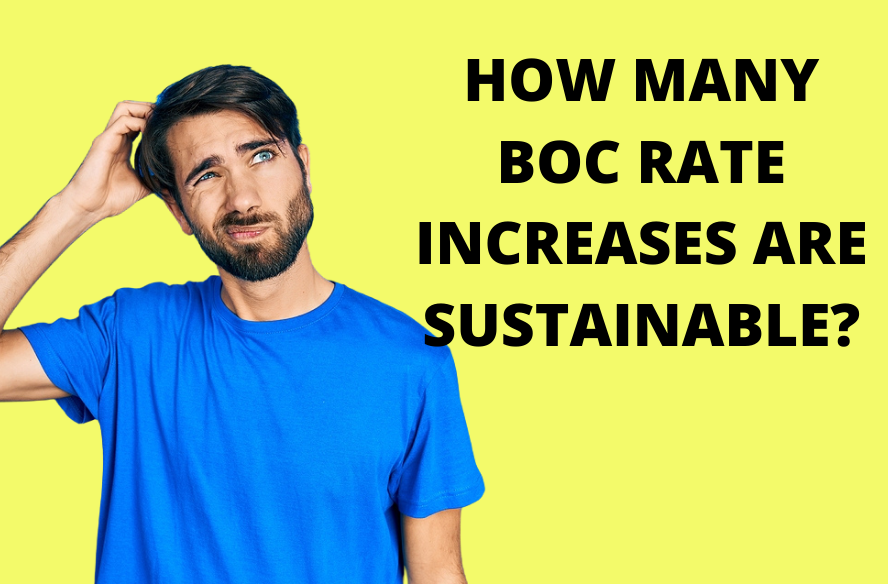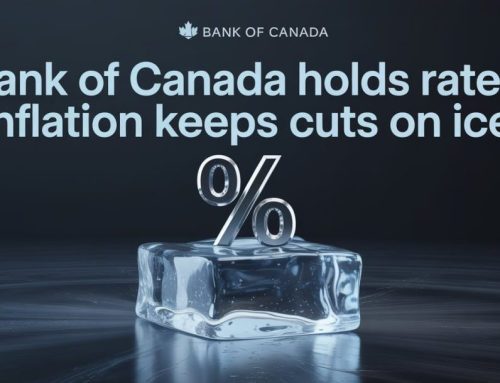It’s no big secret that the Bank of Canada will be increasing their key policy rate (overnight rate) multiple times in 2022. What we don’t know is when or how often it will occur.
With all the talk about rate increases, many are asking if they should be choosing a fixed rate, or ‘locking in’ by converting a variable rate into a fixed.
But is this a good idea?
The effects of rate increases are often blown out of proportion, causing panic, and leading to swift and generally costly decisions.
While fixed rates are right for some, it’s important to understand the effects of projected increases will have on you prior to making any decisions.
The Large Spread Between Fixed and Variable Rates
The spread between fixed and variable is the largest it’s been in years. Yes, the prime rate will increase, but the spread between fixed and variable has now grown to roughly 1.60% or more in most cases. When the Bank of Canada changes their rate, it’s generally done in 0.25% intervals. This means that they would need to increase it seven times before today’s variable rate moves above today’s 5 year fixed option.
But how long will it take for the Bank of Canada to increase their rate seven times.
Even if the variable rate increases above the 5 year fixed rate you were offered at the time of approval, it doesn’t mean that would have been the better choice. It just means that you’ll start to give back some of your savings. In fact, your variable rate can substantially surpass the original 5 year fixed you were offered, while still coming out ahead with variable. I’ll give examples of this later in this blog.
How Many Rate Increases Can We Expect in 2022?
Some economists are predicting that the BOC could increase by as many as five times in 2022. I personally think this is a bit pessimistic. Anything is possible however.
The Bank of Canada has already made it clear that they need to increase their rate, but they have to be careful not to move too quickly. It can take anywhere from 12 to 24 months to determine the full economic impact of a rate increase. Consumer debt is at a record high, which can increase the economic impact of each upward move. This is yet another reason why they need to proceed with caution.
While anything can happen, I think three rate increases by the end of the year is more realistic. If they end up increasing five times as some are predicting, then that increases chances of a downward adjustment to follow. The faster they increase their rate, the sooner they will need to make a move in the opposite direction.
Rate decreases will come. It’s just a matter of when.
When Can We Expect The First Increase?
The next scheduled rate announcement will be on March 2nd. The chances of a rate increase on this date are high, but it’s still possible that they could hold off until their following scheduled announcement on April 13th. I would expect to see a 0.25% increase on one of these dates. At this stage, it’s close to impossible to predict when they will make their move. We may as well flip a coin. The Bank of Canada doesn’t even know at this point.
Fixed Mortgage Rates Have Increased
Fixed mortgage rates have now increased to anywhere from 2.55% to 2.99%, depending on your situation, which puts even more distance between fixed and variable. Variable rates range from as low as 0.90% (prime -1.55%) for an insured mortgage, to 1.40% (prime -1.05%), and everywhere in between.
Now that we’ve discussed the current mortgage rate landscape, we can now dive into the topic of this blog:
How Many Rate Increases Are Sustainable?
I’m going to run a few scenarios to demonstrate the impact of increasing rates on a variable rate mortgage. This will give you a clearer picture on what these rate increases mean in real numbers, which should help you to choose between a fixed or a variable rate.
We’re going to use the same numbers for each scenario:
Mortgage amount: $500,000
Amortization: 25 years
5 year variable rate: Prime -1.45% (1.00%)
5 year fixed rate: 2.59%
Current prime rate: 2.45%
Scenario 1 – Eight Rate Increases
Based on a rate increase two months after closing, with a total of three rate increases in 2022, two more by the end of 2023, and then once per year thereafter.
Time of Increase % Rate Change Rate After Increase
2 months +0.25% 1.25%
6 months +0.25% 1.50%
9 months +0.25% 1.75%
1 year 6 months +0.25% 2.00%
1 year 9 months +0.25% 2.25%
2 years 9 months +0.25% 2.50%
3 years 9 months +0.25% 2.75%
4 years 9 months +0.25% 3.00%
Your rate at the end of the term: 3.00%
Should the above scenario play out, you would have come out ahead by $10,422 in favour of choosing the variable rate. A pretty substantial number!
Scenario 2 – Eleven Rate Increases
Based on the first rate increase occurring two months after closing, with a total of three rate increases in 2022, and increasing every six months thereafter.
Time of Increase % Rate Change Rate After Increase
2 months +0.25% 1.25%
6 months +0.25% 1.50%
9 months +0.25% 1.75%
1 year 3 months +0.25% 2.00%
1 year 9 months +0.25% 2.25%
2 years 3 months +0.25% 2.50%
2 years 9 months +0.25% 2.75%
3 years 3 months +0.25% 3.00%
3 years 9 months +0.25% 3.25%
4 years 3 months +0.25% 3.50%
4 years 9 months +0.25% 3.75%
Your rate at the end of the term: 3.75%
In this scenario, your variable rate at the end of five years would be 1.16% higher than the 5 year fixed offered at time of approval. Should this scenario play out, you would still end up ahead with the variable rate by $4,312.69 by the end of your term.
Scenario 3 – Thirteen Rate Increases
Based on the first increase occurring one month after closing, with a total of five rate increases in 2022 and increasing every six months thereafter.
Time of Increase % Rate Change Rate After Increase
1 months +0.25% 1.25%
2 months +0.25% 1.50%
3 months +0.25% 1.75%
6 months +0.25% 2.00%
9 months +0.25% 2.25%
1 year 3 months +0.25% 2.50%
1 year 9 months +0.25% 2.75%
2 years 3 months +0.25% 3.00%
2 years 9 months +0.25% 3.25%
3 years 3 months +0.25% 3.50%
3 years 9 months +0.25% 3.75%
4 years 3 months +0.25% 4.00%
4 years 9 months +0.25% 4.25%
Rate at end of term: 4.25% Winner: Fixed by $1,585.59
The Overall Winner: Variable
It would take thirteen rate increases at the intervals mentioned above for fixed rates outperform the variable rate options. Yes, the fixed rate would have been the better choice if the third scenario were to come to fruition, but not by much.
The above situations are not realistic however.
Why?
Because we didn’t factor in any rate drops.
There has never been a five year period where the Bank of Canada has increased their rate without a decrease withing the same five year period. The last time they went five years without decreasing their rate was between 1945 and 1955. Ten years in total. However, they didn’t increase during that period either.
The faster the increases come, the sooner they will need to make a downward correction. The overnight rate is a monetary tool used to stabilize the market when tendering in one direction and the BOC plays a balancing act to achieve this stability. This is not a perfect science however.
If we were to add in a single rate drop into the above three scenarios three at the 2 year 6 month mark, the new results would be as follows:
Scenario One – Savings increase from $10,422 to $13,187
Scenario Two- Savings increase from $4,312 to $7,110.06
Scenario Three – Instead of the fixed rate winning by $1,585, the variable rate becomes the new winner by $1,247.
Conclusion
We know that prime rate increases are coming, and the uncertainty of what we can expect moving forward can be a scary thought for many. However, once you understand the added protection of a larger spread, and how significant rate increases translate into real numbers, variable rate mortgages become a lot less intimidating.
If you’re still unsure, I would highly recommend reading my following blogs:
The Ultimate Guide To Choosing Fixed Vs. Variable
Are Variable Rate Mortgages Still A Good Choice?
*The above calculations are based on following my strategy of increasing your variable rate payment to match the payment of the fixed rate alternative. This compares apples to apples, and accounts for the time value of money.








Leave A Comment